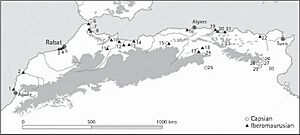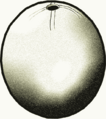Capsian culture facts for kids
 |
|
| Geographical range | North Africa, possibly East Africa |
|---|---|
| Period | Neolithic – Bronze Age |
| Dates | c. 8,000 – c. 2,700 BC |
| Type site | El Mekta |
| Major sites | Medjez II, Dakhlat es-Saâdane, Aïn Naga, Khanguet El-Mouhaâd, Aïn Misteheyia, Kef Zoura D, El Mekta. |
| Preceded by | Iberomaurusian |
| Followed by | Libyans |
The Capsian culture was an ancient way of life in North Africa. It existed from about 8,000 to 2,700 BC. This culture was active during the late Mesolithic (Middle Stone Age) and Neolithic (New Stone Age) periods. It was mainly found in a region called the Maghreb. This area includes modern-day Tunisia, Morocco, and Algeria.
The Capsian culture gets its name from the town of Gafsa in Tunisia. In ancient Roman times, this town was known as Capsa.
Contents
Life in the Capsian Culture
The Capsian people lived mostly in what is now Tunisia, Morocco, and Algeria. Their culture is often divided into two main parts:
- Capsien typique (Typical Capsian)
- Capsien supérieur (Upper Capsian)
Sometimes, a third period called Capsian Neolithic is also mentioned. These different periods show changes in how they made tools and lived.
Environment and Food
During the time of the Capsian culture, the Maghreb region looked like a wide, open grassland. It was similar to parts of modern East Africa. There were also Mediterranean forests in higher areas.
The Capsian people ate many different kinds of animals. These included large animals like aurochs (an ancient type of cattle) and hartebeest (a type of antelope). They also ate smaller animals like hares and even snails. We don't know much about the plants they ate. Later, during the Neolithic period, there is some proof that they had domesticated animals. These were likely goats or sheep that were brought in from other places.
People of the Capsian Culture
The people of the Capsian culture were modern Homo sapiens. Scientists have studied their skulls and bones. They have found that these people had different physical features. Some researchers think they might have been related to people who came from the east. Others believe they were a group that had lived in the area for a very long time.
Some historians think the Capsian culture might be linked to the very first speakers of the Afroasiatic languages. This is because of where and when the culture existed.
Art and Beliefs
We don't know much about the Capsian people's religion. However, how they buried their dead suggests they believed in an afterlife.
They created a lot of art. This included pictures and designs carved into rocks. They also used ochre (a natural earth pigment) to color their tools and even their bodies.
They were very creative with Ostrich eggshells. They used them to make:
- Beads for decoration
- Containers for liquids or other items
Seashells were also used to make necklaces. An older practice of removing the two front bottom teeth continued sometimes. But it became less common over time.
Gallery
See also
- Ifri n'Amr or Moussa
- Kelif el Boroud
- Prehistory of Central North Africa
- African humid period




